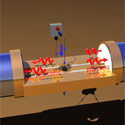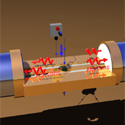Noisy conductors shed light
A quantum conductor with current fluctuations emits photons. When the conductor is at equilibrium, these photons exhibit chaotic statistics, similar to that seen in radiation off a black body. However, once the conductor is dislodged from equilibrium (for example, to a regime where the currents fluctuate due to quantum shot noise), the photon statistics is expected to become more complicated.
In trying to understand the connection between quantum conductors and quantum optics, theorists have made different predictions on the nature of this non-Poissonian statistics. Writing in Physical Review Letters, Eva Zakka-Bajjani and colleagues at CEA in Saclay, France, study the statistics of microwave photons in a low-temperature tunnel junction with shot noise. They investigate photon correlations using the so-called Hanbury Brown-Twiss interferometer setup, first used in 1956 to study interference patterns in starlight. A couple of theoretical papers [1] in the early 2000s explained that a mesoscopic conductor could emit photons with nonclassical, possibly sub-Poissonian, statistics. The authors at Saclay have tested that theory on the simplest quantum conductor: a tunnel junction. They find that, in agreement with that theory, photons emitted off the tunnel junction do exhibit chaotic statistics, even with low electron noise (fewer photons). Their work also provides a general guide to studying photon statistics of mesoscopic conductors with stronger electronic correlations. – Sami Mitra
[1] C. W. J. Beenakker and H. Schomerus, Phys. Rev. Lett. 86, 700 (2001); Phys. Rev. Lett. 93, 096801 (2004).





